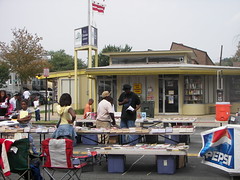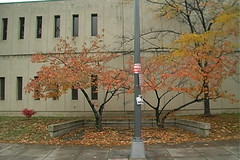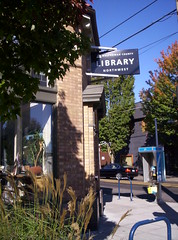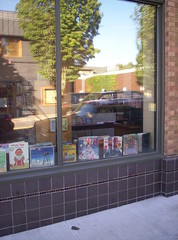Asking WWJJD? (Libraries and mixed-use development)
---------------------------
Note: the library mentioned here, Benning, is not the one I was thinking of, Langston Community Library, when I wrote the entry below. In any case, this doesn't change the argument. For an update and clarification, see "A correction on my statement about the Benning Road library." Updated: 10.12.2006
---------------------------
What would Jane Jacobs Do?*
Just because developers control the DC Library Board these days doesn't mean that they are always wrong--most of the time, sure, but not always.
Both Gary Imhoff in themail and Mark Jenkins in the Washington City Paper online blog weigh in unfavorably about the idea of mixed-use redevelopment of certain DC Public Libraries, in specific discussing the Benning Road and R.L Christian Libraries. I don't have a photo of the Benning building, but it's exactly the same as the one on H Street.
 Bookseller in front of the R.L. Christian Library during the H Street Festival. New paint job courtesy of the Sprenger-Lang Foundation/Atlas Performing Arts Center.
Bookseller in front of the R.L. Christian Library during the H Street Festival. New paint job courtesy of the Sprenger-Lang Foundation/Atlas Performing Arts Center.This is an instance where I have to say that I respectfully disagree. (And I mean respectfully. Through their writings, both Gary Imhoff and Mark Jenkins have taught me a lot.)
But in many instances it can make sense to attempt to achieve multiple objectives from public assets. A library little better than a FEMA-provided trailer isn't the best library neighborhoods ought to have. And it's reasonable to use the "air" above to accomplish other social and public policy objectives.
 AP Photo of FEMA Trailers in Chalmette, Louisiana by Bill Haber.
AP Photo of FEMA Trailers in Chalmette, Louisiana by Bill Haber.E.g., I think it's laudable that the proposal for redeveloping the H Street site proposes 100% affordable housing on floors above, as well as a better and expanded library. I can't think of a much better use for the space above the ground floor (unless it were to be more library). People are clamoring for the production of more affordable housing. The City Government stepped up to do so and look what happens.
(If you join the hstreetdc yahoogroup (you can set it to nomail...) you can view the very large (4.5MB) pdf file entitled "NCRC Concept Plan.")
The Benning Library is the exact configuration of the library on H Street and is equally pathetic. I think residents of the city deserve, and can have, more. Instead of visceral opposition, why isn't this considered a sound application of Jane Jacobs' principle of mixed primary uses?
This is another example of DC citizens having abysmally low expectations.
Don't get me wrong. I wouldn't likely recommend mixed-use redevelopment of historic library buildings in the city (for example, the Southeast and Northeast libraries are Carnegie-developed libraries).
But crappy one story buildings from the 1970s onward are strong candidates for redevelopment. Library buildings such Benning, Christian, and the Daniel Building in Shaw scream out for redevelopment in ways that strengthen rather than wreck the streetscape and promote neighborhood stabilization and commercial district revitalization.
 Watha T. Daniel Public Library, Shaw. A9 photo.
Watha T. Daniel Public Library, Shaw. A9 photo.Which is why I am against the Library Board's planning report calling for large single floor branch libraries.
This is antithetical to overarching principles of urban design, which should dictate how all DC Government agencies proceed when it comes to facilities development--providing further confirmation that Urban Design should be the primary element guiding the Comprehensive Plan and planning practices for the District of Columbia.
This library in Portland, Oregon's Nob Hill District connects to and embraces the street, while the Daniel Library facade says "stay away."
 Nice entrance at the corner of two streets, attractively planted ornamental garden.
Nice entrance at the corner of two streets, attractively planted ornamental garden. Zero setback on one side of the building puts the building right at the sidewalk, which is typical of buildings in traditional commercial districts. Attractive window displays show that the Library can merchandise its windows as well as any retail business located in the commercial district.
Zero setback on one side of the building puts the building right at the sidewalk, which is typical of buildings in traditional commercial districts. Attractive window displays show that the Library can merchandise its windows as well as any retail business located in the commercial district.---------------
* I can't claim that Jane Jacobs would automatically approve this idea, but it makes sense based on her writings.
Index Keywords: libraries; mixed-use; urban-design-placemaking



0 Comments:
Post a Comment
<< Home